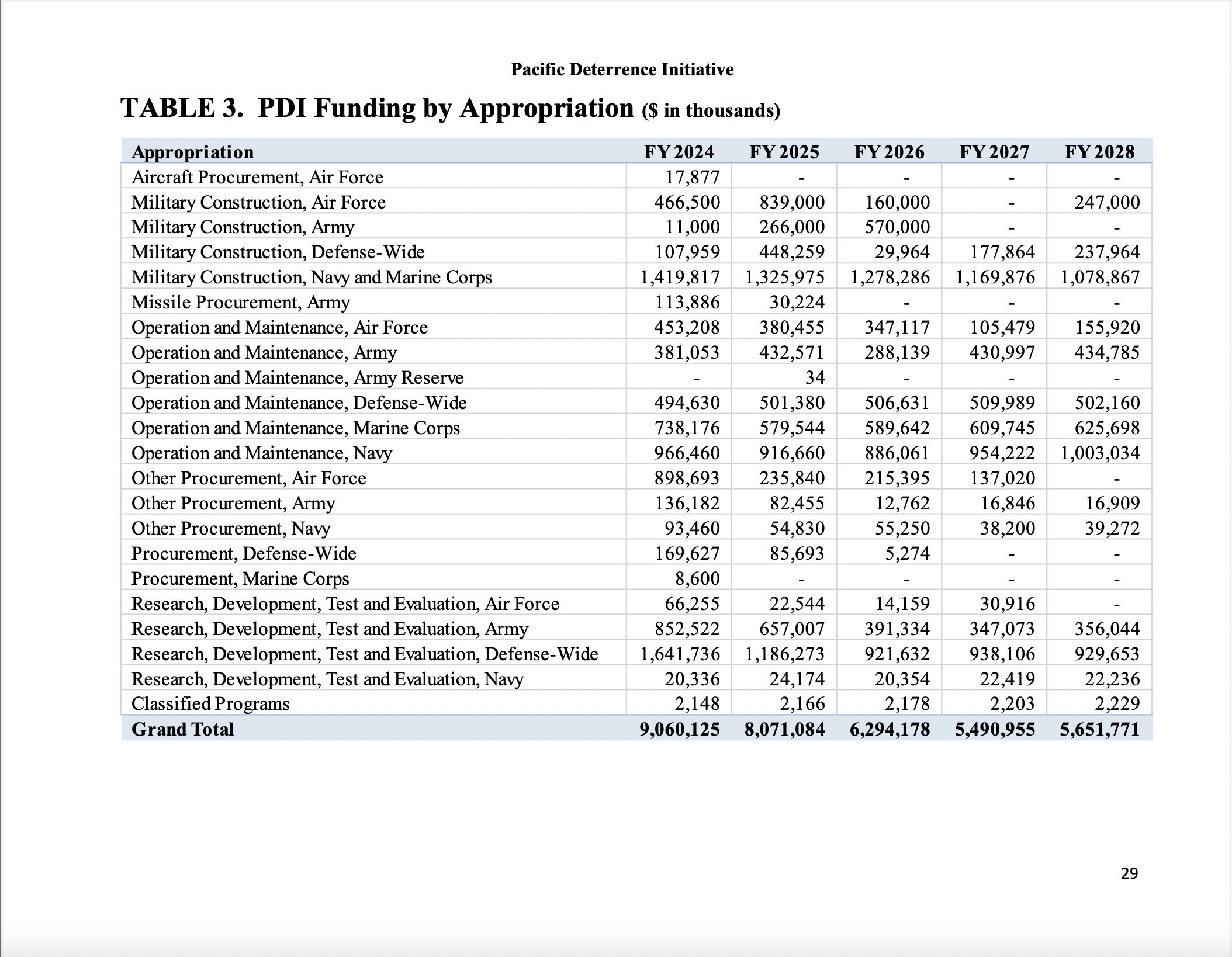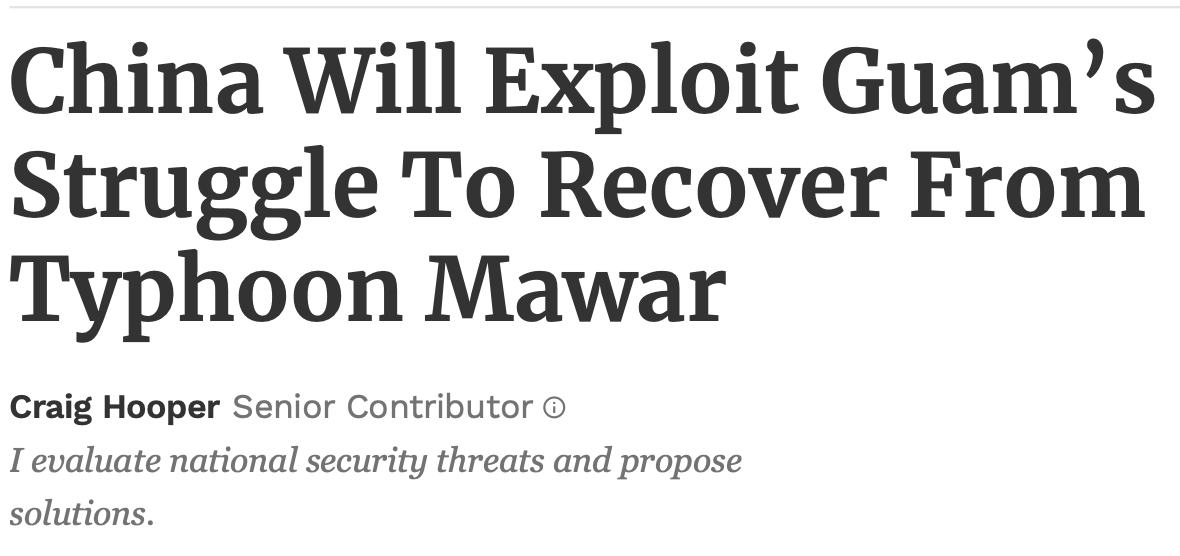An Alabama congressman, whom Guam Del. James Moylan has befriended, appears to be pulling the military buildup rug from under Guam and the CNMI’s not-so-watchful eyes, as southeastern pork barrel republicans profit off the high cost of groceries, fuel, and commodities in the Mariana Islands.
And in a stunning admission, the republican Moylan who portrays himself as a Defense hawk and supporter of military investments into Guam said he gave his stamp of approval to a shoveling out of defense spending from this part of the world and onto the pork barrel heaps in Alabama, Mississippi, and Hawaii, making this a not-in-my-back-yard position not seen since the A-76 Study of the 1990s.
The U.S. military wants to build the defenses needed to meet threats and potential threats from China in its two U.S. strongholds closest to China: Guam and the CNMI. The program, Pacific Deterrence Initiative, rolled out in March with a $9.1 billion budget request for next fiscal year. According to that request, the President and the military, want that money spent in the western Pacific hemisphere (read: Guam and the CNMI).
“It consists of targeted investments that enhance U.S. force posture, infrastructure, presence, and readiness, as well as the capacity and capabilities of U.S. allies and partners, specifically in the Indo-Pacific region primarily west of the International Date Line (IDL),” according to the March 2023 submission by the Defense Department of an initial $9.1 billion budget for Fiscal Year 2024.
PDI funding for the foreseeable future will be much greater than the first year investment. According to a table of funding breakdown provided by the Office of U.S. Congressman Gregorio “Kilili” Sablan of the CNMI, the military plans to spend more than $34 billion in this region over the next five years.

But, pork barrel republicans, who control the U.S. House of Representatives, appear to have other plans that will benefit their beleaguered hometowns at the expense of what once was considered fool-proof economic buildup for the Mariana Islands.
And the plot thickens. Mr. Moylan’s new friends whom he brought to Guam en route to a Taiwan junket, smiling for the cameras and all, are from the same group of pork barrel legislators who also benefit from the very Jones Act they protect at all costs. The same Jones Act that causes a $4 jar of mayonnaise in Alabama to cost a Mariana islander $11.
The Pacific Deterrence Initiative
The U.S. Department of Defense has, for years, seen the threat from the People’s Republic of China “as its preeminent pacing challenge,” according to a March 2023 budget submission for its response to this challenge: the Pacific Deterrence Initiative, or PDI.
According to the report, “a great amount of the Department’s investments and efforts are focused on this threat and strengthening Indo-Pacific deterrence.”
Indeed, over the next five years, DOD plans to spend more than $34 billion in the western portion of the U.S. Indo-Pacific Command (INDOPACOM) area of responsibility.
“It consists of targeted investments that enhance U.S. force posture, infrastructure, presence, and readiness, as well as the capacity and capabilities of U.S. allies and partners, specifically in the Indo-Pacific region primarily west of the International Date Line (IDL),” the report to Congress states. While Hawaii is part of PACOM, it is not west of the IDL.
The first wave of that investment was anticipated to cost $9.1 billion for next fiscal year; an amount budgeted by the President, which appeared on both the U.S. House of Representatives and U.S. Senate versions of the nation’s annual military spending authority legislation, the National Defense Authorization Act (NDAA).
“To sustain our military advantage over China, it makes major investments in integrated air and missile defenses and operational energy efficiency, as well as in our air dominance, our maritime dominance, and in munitions, including hypersonics,” U.S. Defense Secretary Lloyd Austin III stated in a March 13, 2023 news release about the budget request. “This budget includes the largest ever request for the Pacific Deterrence Initiative, which we are using to invest in advanced capabilities, new operational concepts, and more resilient force posture in the Indo-Pacific region.”
And to remove any question about Guam and the CNMI’s potential share in this one-year $9.1 billion investment to be followed by $25 billion through Fiscal Year 2028, one need only read the next sentence of his statement:
“It also enables groundbreaking posture initiatives in Guam, Mariana Islands, the Philippines, Japan, and Australia.”
Kilili, as the CNMI federal House delegate affectionately is known in the Marianas, did not hesitate to confirm his support of military investments throughout the Mariana Islands. While his Guam counterpart, Mr. Moylan, has also outwardly expressed this same belief for the island, his actions on the House Armed Services Committee regarding this particular program tell a different story.
Tables detailing breakdowns of funding among the Army, Navy (to include the Marine Corps), Air Force, and Space Force are contained in the budget submission. Most of the entries are not location specific, though much of the planned investment are for operations, construction, maintenance, research, training, testing, and procurement of equipment and supplies for programs and force movements that match previously-stated objectives of both INDOPACOM and Joint Region Marianas for Guam, Tinian, and Saipan.
Many of the budget entries are Guam-specific. For example, part of a $667 million U.S. Air Force program calls for the construction of “the North Aircraft Parking Ramp at Joint Region Marianas.”
Another $1.5 billion in military construction by the Navy will go specifically to Marine Corps bases in Australia and Guam, with subrows of construction projects in the hundreds of millions each.
According to the report $801 million alone will go to the development of the Missile Defense Agency (MDA) on Guam, to include the $169 million procurement of the major equipment, $385 million for a budget category called “Guam Defense Development,” and seven other various budget subsets.
It is described this way: “MDA activities in this category include funding to support MDA’s contribution to development and integration of a Joint Missile Defense System (MDS) for the defense of Guam against ballistic, hypersonic and cruise missile threats. This includes MDA partnering with the U.S. Army to fully mature the architecture to integrate Army and MDA elements within an on-island command center. The architecture acquisition process also provides environmental, engineering, and interoperability activities to balance costs and associated risks. The inter-Department partnership will plan appropriate flight tests to validate Defense of Guam MDS capabilities. MDA will continue P&D efforts for Military Construction projects to support the Guam Architecture and continue to develop and field a multi-faced distributed land-based Army Navy Transportable Radar Surveillance (AN/TPY-6) radar. MDA will also continue procuring Vertical Launch System and Aegis Weapon System components needed to support the Defense of Guam Architecture.”
The breadth of these potential investments to Guam came as a surprise to the Guam Chamber of Commerce’s 20-year-old Armed Forces Committee, which has been an invaluable advocate for defense spending on the island.
“How do you even spend that money?” Chamber president Catherine Castro said as she reviewed the table adding up to the $34 billion five-year spending plan.
“I wish the congressman would have said something,” AFC member, Chamber past chairman, and longtime businessman and newspaper publisher Lee Webber said, referring to the fact that Jim Moylan has never publicly discussed this budget proposal. Mr. Webber is a combat Marine, having served our country in the Viet Nam war.
Why didn’t Mr. Moylan ever mention the scope of the military’s possible spending plan to his constituents back home? He has constantly boasted about his position on the House Armed Service Committee, one which he credits to his close relationship with House republicans, especially its HASC chairman, Alabama Rep. Mike Rogers.
The 2024 NDAA that passed the House
On July 14, Mr. Rogers trumpeted the House’s passage of its version of the NDAA.
…until you read what the HASC – specifically, Mr. Rogers – added to the NDAA.
A tiny section of the NDAA appeared first in a July 3 mark up draft by the HASC, and is entitled: “Assessment on use of certain areas in southeastern United States for testing and training in support of Pacific Deterrence Initiative.”
It had the appearance of an oxymoron Kandit had to explore further.
Why would Congress want to authorize expenditures in southeastern states near the Atlantic, for testing and training needed in the Pacific?
According to the new NDAA language, which passed the House but is not currently contained in the Senate version, this Section 366 commands the Secretary of Defense to augment assumptions for the PDI and include the southeastern United States in its area of application. Within 180 days of enactment of the NDAA – a timeline far shorter than deadlines the HASC has placed into the NDAA for other studies it demands – the House wants the Defense Secretary to identify “any test or training area located outside of the area of responsibility of the United States Indo-Pacific Command (and in particular, in the southeastern region of the United States) with the potential to be used to expand the capacity and persistence of theater-level operations, including any such areas owned or operated by any Federal department or agency, State, institution of higher education, or commercial entity.”
The language goes on to command the Defense Secretary to include analysis, identification, and assessment of varied ways to move funding from the multi-billion dollar Pacific Deterrence Initiative outside the INDOPACOM area of responsibility, and to the other side of the globe to Alabama, Mississippi, and Florida.
Guam’s lone non-voting delegate to the House – the Mr. Moylan who proudly sits on the HASC – says this addition to the NDAA language does not subtract anything from either Guam or the CNMI. In fact, Mr. Sablan, or Kilili of the CNMI, confirmed that the House increased PDI funding from the $9.1 billion the President requested, to $9.7 billion.
“Section 366 is additive not subtractive and is intended to ultimately increase DoD’s focus on INDOPACOM not detract from operations already conducted in the region,” Moylan’s communications director Hannah D’Avanzo said.
Nothing in the NDAA the House passed states this. In fact, the Rogers addition to the NDAA broadly defines the political pivot from INDOPACOM to the southeastern United States in terms of testing or training areas to be funded as including “any range or other facility that may be used by the Secretary of Defense for testing or training purposes.”
More startling than Mr. Moylan’s unfounded assertion that Section 366 will not affect Guam or the CNMI’s potential security and economic outlook is his outlook on the matter. According to Ms. D’Avanzo:
“Congressman Moylan’s position on and awareness of Section 366 of the NDAA is that is a positive development for the PDI for three key reasons. First, this amendment allows the Department of Defense (DOD) to conduct training that may otherwise pose harm to the people of Guam in safe geographies elsewhere in the nation. Second, at present Pacific facing jurisdictions such as Hawaii are the primary stakeholders in INDOPACOM related decisions, by expanding this to the south east this makes communities such as HASC Chairman Rogers’ home state of Alabama more deeply invested in the success of INDOPACOM.”
And then, there’s the clincher:

“The congressman did participate in the inclusion of this language into the NDAA, and approved this language for the aforementioned reasons,” Ms. D’Avanzo confirmed.
Guam’s own and lone delegate to Congress – a professed defense hawk and so-called supporter of the military buildup – put Guam’s stamp of approval on a plan to move funding and resources away from the INDOPACOM area of responsibility, and send those resources to Alabama, Mississippi, and Florida. This is, by far, the largest NIMBY a Guam delegate to the House has ever admitted to.
The Guam Chamber Armed Forces Committee members had no idea this had happened.
Neither did Joint Region Marianas, according to relevant sources.
In fact, on a tour of the training compound and firing ranges by the U.S. Marine Corps on Guam, public affairs officer Major Diann Rosenfeld emphasized the importance of the facilities on Guam, not just for the Marines who will relocate to the island by the end of 2024, but for local law enforcement, and for the nation’s allies.
And in the deterrence to an emerging China, those allies are all around Guam; not the southeast United States mainland.
In fact, a great portion of the training schedule at these facilities will be dedicated to multi-national exercises with America’s allies, Ms. Rosenfeld said.
It is a position echoed separately by Mark Sablan, also a member of the Chamber Armed Forces Committee, and the senior executive for SPPC Guam, which operates 76 gas stations and Circle K convenience stores.
His colleague, Mr. Webber, honed in on Guam’s delegate’s contention that some of the training that would be moved to places like Alabama would pose harm if that training happened on Guam.
“I don’t quite get what would be safe for Alabama that wouldn’t be safe for Guam,” Mr. Webber said, repeatedly throughout the interview with the Armed Forces Committee. “Did he say, what?”
No, Mr. Moylan did not respond to the follow up question.
“It would be very interesting to see what kind of exercises Congress wants to have in the southern states,” Ms. Castro, the Guam Chamber president said.
Ms. Rosenfeld, giving Kandit a tour of the training and firing range facilities, named every precaution, safety net, and system of compliance with military protocol and the National Environmental Protection Act as she explained wildlife mitigation and historic preservation amid the future training and firing range compounds. Scattered through those explanations, were her passionate defenses of combat simulations – the climate, foliage, sub-urban designs, humidity, and other factors unique to this part of the world – that will save lives in the battlefield.
“If they make a mistake here,” she said as she took us through a building under construction that will act as a live-fire training zone, “we can dial in on that, so that they’re more prepared to not make those mistakes in a real life situation.”
And the moisture in the air, the natural sounds, and the sweat coming off of men and women wearing 60 pounds of gear… those are the details of the training simulation that help to prepare Marines for the difference between life and death in actual combat, she said.
But in Mike Rogers’ NDAA, those factors are secondary to his desire to take at least some of the PDI’s projected $34 billion and train and test instead in a totally different theatre.
The unfurling ‘Don’t-spend-it-on Guam’ narrative
The typhoon
On May 24, Typhoon Mawar brought super typhoon strength winds and rains to the northern parts of Guam, which included Andersen Air Force Base, and Marine Base Camp Blaz. The storm, the first of its kind in more than 20 years, knocked out the island’s power system, which cascaded into the loss of running water for a few days.
On June 9, Forbes made the unusual decision to publish prominently an article by senior contributor Craig Hooper entitled “China Will Exploit Guam’s Struggle To Recover From Typhoon Mawar.”
His lede, “For military strategists, Guam’s slow recovery from Typhoon Mawar is a real concern,” differed substantially from statements made by the military itself. This is not to mention the fact that no where in the article does Mr. Cooper name those so-called military strategists.
“Joint Region Marianas was not approached for comment by Mr. Craig Hooper or Forbes Magazine,” Joint Region Marianas public affairs officer Lt. Commander Katherine Koenig confirmed.
“The remote island, host to several critical military facilities,” Mr. Hooper goes on to state in his article, “is a linchpin for U.S. security in the Western Pacific. As a potential target for Chinese societal influencing, cyber-attack or military assault, Guam is doing of poor job of demonstrating it can support the island’s 170,000 U.S. citizens during a crisis.”
The commander of Joint Region Marianas provided a different outlook, though:
“Typhoon Mawar swept through Guam indiscriminately,” said Joint Region Commander, Rear Adm. Greg Huffman. “Although we suffered damage both on and off our installations, I am proud of the teamwork and resiliency demonstrated by everyone throughout the island. Every time we take a hit, we learn and come back stronger. I am optimistic about our recovery process and I believe that we are well postured for any future threat to Guam.”
Why the off-target hit on Guam in Forbes, then? Consider the timing and the players.
The good ol’ boys club of Alabama
Within days of the publication, Guam Del. Moylan brought his celebrated buddy, House Armed Services Committee chairman Mike Rogers, along with other members of the HASC, to Guam en route to a Taiwan junket. According to the Marine Corps Camp Blaz protocol office, Mr. Rogers did not visit the training or firing ranges, despite their importance to the PDI and total defense posture.
Then, days later, the HASC introduces Section 366 as a mark up.
Mr. Hooper is a former business development executive who handled congressional relations for the Navy ship manufacturer Austal USA, which is based in Alabama – the home of House Armed Services Committee Chairman Mike Rogers. Also on his committee is fellow Alabama representative Dale Strong. As one studies the republican membership of both the House and Senate Armed Services Committees, the list clearly includes a powerful bloc of republican congressmen and senators from the U.S. southeast region, namely: Joe Wilson of South Carolina, Austin Scott of Georgia, Trent Kelly of Mississippi, Matt Gaetz of Florida, Michael Waltz of Florida, Carlos Giminez of Florida, Nancy Mace of South Carolina, Cory Mills of Florida, and Rich McCormick of Georgia. Meanwhile, the Senate Armed Services Committee includes another Alabama name – Tommy Tuberville, along with fellow republicans, ranking member Roger Wicker of Mississippi, and Rick Scott of Florida.
An October 7, 2021 publication by John Glenn in the Energy Institute of Alabama newsletter quotes then-Austal USA president Rusty Murdaugh’s appreciation for Mr. Rogers’ record of support for the company.
“Congressman Rogers has been a champion of advancing our Nation’s military readiness throughout his career, and his support of Austal shipbuilding has been unwavering,” Murdaugh said.
“Austal USA–the builder of the Independence-variant of the littoral combat ship and the expeditionary fast transport vessel–is also ready to increase its capacity should the Navy require it, said Craig Perciavalle, the company’s president,” according to the Congressional Research Service, citing a March 2017 “press report.”
“The key thing for us is to keep the manufacturing lines hot and really leverage the momentum that we’ve gained on both of the programs,” he said, according to the report.
Austal has a 164-acre yard in Mobile, Alabama.
The Navy earlier this year released a report stating three options for a Naval force in a 30-year shipbuilding plan: 316 ships, or 327 ships, or 367 ships. According to the report, in June, the Navy sent Congress a classified report stating its true desire, to build 373 ships. The reason that number was not publicly released is because of a dim reality: scarcity of money and shipyard capacity.
Enter the once-flourishing Guam Shipyard.
According to the Congressional Research Service’s report, Navy Force Structure and Shipbuilding Plans: Background and Issues for Congress, shipbuilding and ship repair to keep a 31 amphibious ship fleet operational at any given time is non-negotiable. “And the Marine Corps is ready to fight about it,” the CSR report states.
“We’ve been on that for years now,” the Guam Chamber’s Mr. Webber said, his colleague, Mr. Sablan adding that the recommissioning of the Guam Shipyard Repair Facility would cause an amazing boom in the economy.
The continuously missing links to that reopening are the labor force to run it, and the money to rebuild it.
Money, like the kind Mr. Moylan has put his stamp of approval to flow to the southeastern United States.
Following this report will be a second part focusing on the impacts of these actions on shipping, ship repair, and the Jones Act that affects Guam and Micronesia.






1 Comments
Frenchie
07/20/2023 at 10:25 AM
Excellent article.
Looks like Jimmy has not learned how to dance the Potomac two steps.